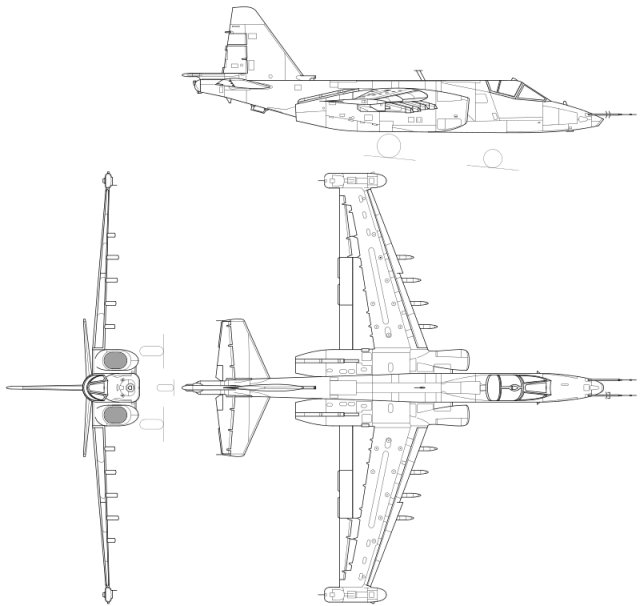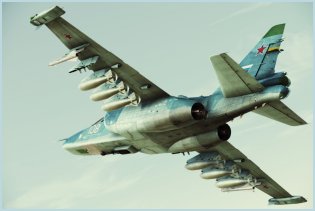Su-25 Frogfoot Sukhoi
| a | ||||||||||||||||||||||
|
Sukhoi Su-25 / Su-25SM Frogfoot close air support combat aircraft
|
||||||||||||||||||||||
|
|
||||||||||||||||||||||
 |
||||||||||||||||||||||
|
|
||||||||||||||||||||||
|
The Sukhoi Su-25 (NATO reporting name: "Frogfoot") is a single-seat, twin-engine jet aircraft developed in the Soviet Union by the Sukhoi Design Bureau. Sukhoi Design Bureau started work to produce the Su-25 attack aircraft in 1968. The new plane was meant for support of troops from directly over the battlefield and was designed to be an extremely easy-to-use and maintain subsonic jet aircraft with superior manoeuvrability and damage control. The Su-25 performed its maiden flight on 22nd February 1975. The USSR Air Forces entered the Su-25 into service as part of the inventory of separate attack aircraft regiments (SAAR) under district (army) command. The first 11 production planes were assigned in April 1981 to 80 SAARs stationed at the Sital-Chai airfield (Transcaucasian MD).
Starting in 2001, Design Bureau has been implementing a programme to upgrade the Su-25 planes in service in the Air Forces of Russia to the Su-25SM version. The programme's leading facility is the 121st ARP of the Defence Ministry (Kubinka), the work being performed under the leadership of, and in cooperation with, Sukhoi Design Bureau. The first upgraded plane, Su-25SM-1, was flown on 3rd March 2002. Different variants of the Su-25 "Frogfroot" combat aircraft remain in service in several countries: Angola, Azerbaijan, Belarus, Bulgaria, Chad, Democratic Republic of the Congo, Czech Republic (in storage), Equatorial Guinea, Ethiopia, Georgia, Gambia, Iran, Iraq, Ivory Coast, Kazakhstan, North Korea, Peru, Russia, Sudan, Turkmenistan, Ukraine, Uzbekistan. To date (2015), Su-25s have been produced. |
||||||||||||||||||||||
| Main Variants | ||||||||||||||||||||||
|
- Su-25K: commercial export variant.
- Su-25UB: two-seat variant intended for training and evaluation flights of active-duty pilots, and for training pilot cadets at Soviet Air Force flying schools. The performance did not differ substantially from that of the single-seater. The navigation, attack, sighting devices and weapons-control systems of the two-seater enabled it to be used for both routine training and weapons-training missions. - Su-25UBM: twin seat variant that can be used as an operational trainer, but also has attack capabilities, and can be used for reconnaissance, target designation and airborne control. This variant has a Phazotron NIIR Kopyo radar and Bars-2 equipment on board. Su-25UBM's range is believed to be 1,300 km and it may have protection against infra-red guided missiles (IRGM), a minimal requirement on today's battle fields where IRGMs proliferate. - Su-25UTG: variant of the Su-25UB designed to train pilots in takeoff and landing on a land-based simulated carrier deck, with a sloping ski-jump section and arrester wires. - Su-25BM: target-towing variant of the Su-25 whose development began in 1986. The Su-25BM target-tower was designed to provide towed target facilities for training ground forces and naval personnel in ground-to-air or naval surface-to-air missile systems. It is powered by an R-195 engine and equipped with an RSDN-10 long-range navigation system, an analogue of the Western LORAN system. - Su-25T: a dedicated antitank version. The design of the aircraft is similar to the Su-25UB ( unification of 85%). The variant was converted to one-seater, with the rear seat replaced by additional avionics.[76] It has all-weather and night attack capability. In addition to the full arsenal of weapons of the standard Su-25, the Su-25T can employ the KAB-500Kr TV-guided bomb and the semi-active laser-guided Kh-25ML. - Su-25TM (Su-39): as a second-generation Su-25T, the Su-25TM (also designated Su-39), has been developed with improved navigation and attack systems, and better survivability. While retaining the built-in Shkval of Su-25T, it may carry Kopyo (rus. "Spear") radar in the container under fuselage, which is used for engaging air targets (with RVV-AE/R-77 missiles) as well as ships (with Kh-31 and Kh-35 antiship missiles). - Su-25KM: nicknamed "Scorpion", is an Su-25 upgrade programme announced in early 2001 by the original manufacturer, Tbilisi Aircraft Manufacturing in Georgia, in partnership with Elbit Systems of Israel.The aircraft uses a standard Su-25 airframe, enhanced with advanced avionics including a glass cockpit, digital map generator, helmet-mounted display, computerised weapons system, complete mission pre-plan capability, and fully redundant backup modes. Performance enhancements include a highly accurate navigation system, pinpoint weapon delivery systems, all-weather and day/night performance, NATO compatibility, state-of-the art safety and survivability features, and advanced onboard debriefing capabilities complying with international requirements. It has the ability to use Mark 82 and Mark 83 laser-guided bombs and air-to-air missiles, the short-range Vympel R-73. - Su-28: advanced basic jet trainer, built on the basis of the Su-25UB as a private initiative by the Sukhoi Design Bureau. The Su-28 is a light aircraft designed to replace the Czechoslovak Aero L-39 Albatros. Unlike the basic Su-25UB, it lacks a weapons-control system, built-in cannon, weapons hardpoints, and engine armour. |
||||||||||||||||||||||
| Technical Data | ||||||||||||||||||||||
| Design | ||||||||||||||||||||||
|
The Su25's wings are high-mounted and back-tapered with straight trailing edges. There are pods mounted at the square tips. There are two turbojets mounted alongside the body under the wings. There are semicircular air intakes forward of the wings' leading edges. There are exhausts to the rear of the wings' trailing edges. The fuselage is long, and slender and has a rounded nose. The body tapers to the rear section that overhangs the exhausts. There is a stepped canopy. The tail is swept-back and fin is tapered with a square tip. The flats mid-mounted on the fuselage, unequally tapered with blunt tips.
The Su-25 features high combat survivability owing to the use of an all-welded titanium-armor cockpit and an armored windscreen, fuel tanks with polyurethane foam filling, fire protection of engine compartments damage-resistant structures for load-bearing elements, armor plating of vital units and systems, as well as reinforced fire-resistant control rods capable of remaining intact even when hit by 12.7 mm bullets. |
||||||||||||||||||||||
|
Propulsion
|
||||||||||||||||||||||
|
The Russian Air Force Su-25 aircraft is powered by two Soyuz / Gavrilov R-195s turbojet engines rated at 44.18kN. Cooling air is introduced at the end of the tail cone to reduce the temperature of the exhaust gases and minimise the infrared signature of the aircraft.
The aircraft is equipped with self-sealing, foam-filled fuel tanks with a total fuel capacity of 3,600l. The range of the aircraft can be extended by the provision of four PTB-1500 external fuel tanks, which are carried on the underwing pylons. The Su-25 can also be fitted with 4 x PTB-800 (to be dropped) fuel tanks, allowing a 1,850 km range. The combat radius and ferry range of the aircraft are 375km and 7,500km respectively. The normal range of the Su-25 is 750km. The service ceiling is 7,000m. |
||||||||||||||||||||||
|
Avionics
|
||||||||||||||||||||||
|
The base model Su-25 incorporates a number of key avionics systems. It has no TV guidance but includes a distinctive nose-mounted laser rangefinder, that is thought to provide for laser-based target finding. A DISS-7 doppler radar is used for navigation; the Su-25 can fly at night, in visual and instrument meteorological conditions. The aircraft is equipped with an RSBN tactical air navigation system (TACAN), MRP-56P marker beacon receiving unit, RV-1S radio altimeter and various air data and acceleration indicators. The communications systems include an SRO-2 identification friend or foe (IFF) transponder and a SO-69 air traffic control transponder, together with VHF/UHF transceivers and an air-to-ground radio.
The aircraft's self-defence suite includes various measures, including an operating radar detection set, an active jammer, a flare decoy dispenser and chaff dispensers capable of launching up to 256 flares and dipole chaff. Hostile radar uses are guarded against via an SPO-15 radar warning receiver. The upgraded version for the Russian Air Force, the Su-25SM, which entered service in January 2007, includes new navigation computer, Bars digital avionics system, Pastel countermeasures suite, SUO-39 fire control system and Phazotron Kopyo-25M radar. The upgraded Su-25SM aircraft equipped with the Bars system ensures flight navigation accuracy of up to 10-15 m, which enables the pilot to launch a run-on attack. It ensures also an increase in ground target kill effectiveness by 2 to 3 times and an extension of the weapon suite, including the use of laser-guided high-precision weapons. The Su-25SM can use new combat employement modes for standard weapons (program-corrected target tracking, navigation bombing and others) and various weapons in one attack. The Bars suite also enables a decrease in a pilot workload and simplification of his actions when performing combat operations owing to the use of up-to-date information ad control field in the cabin and automation of the combat employement modes. This avionics suite has increased the combat employement altitude up to 7,000 m. |
||||||||||||||||||||||
| Armament | ||||||||||||||||||||||
|
The wings have ten pylons for carrying a range of air-to-air and air-to-ground weapon systems selected for the mission, in addition with the aircraft's twin-barrel gun, the 30mm AO-17A, installed in the underside of the fuselage on the port side. The 30-mm built-in gun has a fire-rate 3,000 rds/min and a ammunition load of 250 rounds.
The ten external-store hardpoints can carry several different weapon systems: - air-to-surface missiles (2-4 pcs), including Kh-23 (Nato codename AS-7 Kerry), Kh-25ML (AS-10 Karen) and Kh-29l (AS-14 Kedge) - up to 500-kg size aerial bombs weighing up to 4,000 kg - rockets (up to 8 rocket pods), including UB-32A pods for 57mm S-5 rockets, B-8M1 pods for 80mm S-8 rockets, S-24 240mm guided rockets and S-25 330mm guided rockets -two air-to-air short-range missiles, such as the R-3S (AA-2D Atoll) and the R-60 (AA-8 Aphid) - SPPU-22 gun pods can also be installed on the underwing pylons. The pods carry the GSh-23 23mm twin-barrel guns, each with 260 rounds of ammunition |
||||||||||||||||||||||
| Specifications | ||||||||||||||||||||||
|
||||||||||||||||||||||
 |
||||||||||||||||||||||
|
||||||||||||||||||||||































